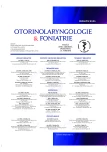Neonatal hearing screening - current situation and how to proceed?
Authors:
Viktor Chrobok 1; J. Dršata 1; M. Janouch 1; Jana Krtičková 1; M. Hloušková 1; L. Bilinová 1; J. Praisler 2; B. Buriánková 3; Z. Kokštein 3; J. Malý 3; Pavel Komínek 4
Authors‘ workplace:
Klinika otorinolaryngologie a chirurgie hlavy a krku, Fakultní nemocnice Hradec Králové, Univerzita Karlova, Lékařská fakulta v Hradci Králové
1; Klinika otorinolaryngologie a chirurgie hlavy a krku, Nemocnice Pardubického kraje, Pardubická nemocnice
2; Dětská klinika, Fakultní nemocnice Hradec Králové, Univerzita Karlova, Lékařská fakulta v Hradci Králové
3; Klinika otorinolaryngologie a chirurgie hlavy a krku, Fakultní nemocnice Ostrava a Lékařská fakulta, Ostravská univerzita
4
Published in:
Otorinolaryngol Foniatr, 69, 2020, No. 1, pp. 3-10.
Category:
Original Article
Overview
Introduction: Screening of neonatal hearing was determined by the methodological instruction of the Ministry of Health of the Czech Republic (Bulletin of the Ministry of Health of the Czech Republic No. 7/2012). Transiently evoked otoacoustic emissions (TEOAE) are used to screen neonatal hearing. A positive screening means the detection of hearing impairment (permanent hearing impairment), a negative screening means the absence of hearing impairment, thus TEOAE is normal. The aim of this procedure is to provide concrete information about the status of neonatal hearing screening in the Czech Republic in the years of 2013 to 2017 and to make a proposal to improve the quality of screening.
Methods: Neonatal hearing screening is performed at three levels: the neonatology workplace, the ENT (phoniatric) rescreening centre, and the ENT (phoniatric) regional centre. Data from all health insurance companies in the Czech Republic were obtained to evaluate nationwide screening of neonatal hearing in the Czech Republic; this included the numbers of reported performance of neonatal screening of hearing (73028) and rescreening of hearing of newborns (73029) between 2013 and 2017. The data were compared with the number of births from data of the Czech Statistical Office (CSO) and the Institute of Health Information and Statistics (IHIS) of the Czech Republic.
Results: The graphs show a gradual increase in the number of neonatal hearing screenings in the Czech Republic from 54% in 2013 to 75% in 2017. The numbers of neonatal hearing rescreenings between 2013 and 2017 range between 5 and 7%. There are noticeable differences between screening and rescreening in individual regions of the Czech Republic.
Conclusions: The correct functionality of hearing defect screening is based on simple screening organization, patient comfort, medical yield, and economic capacity. The schedule of screening and rehabilitation of hearing of newborns recommends the following steps: 1. screening of hearing of physiological newborn during hospitalisation, preferably on the 2nd to 3rd day after delivery by a neonatologic nurse using otoacoustic emissions (it is appropriate to use AABR); 2. hearing rescreening at 3 to 6 weeks of age at the ENT rescreening workplace; 3. completion of diagnostics of hearing disorders by the age of 3 to 6 months at the ENT regional centre. The individual steps are summarized in the Ten Commandments of Neonatal Hearing Screening. The failure to observe this procedure, especially in terms of time, puts the hearing and speech development of a child with permanent hearing impairment at risk. Together we are preparing a revision of the methodological instruction of the Ministry of Health of the Czech Republic through the cooperation of ENT doctors, neonatologists, and pediatritions (Ministry of Health Bulletin No. 7/2012) and are simultaneously trying to create conditions for building a functional nationwide screening of neonatal hearing in the whole Czech Republic.
Keywords:
permanent hearing loss – otoacoustic emissions – universal neonatal hearing screening – newborn
Sources
1. Bush, M. L., Kaufman, M. R., McNulty, B. N.: Disparities in access to pediatric hearing. Curr Opin Otolaryngol Head Neck Surg, 25, 2017, 5, s. 359–364.
2. Dršata, J. a kol. Foniatrie - sluch. Havlíčkův Brod: Tobiáš, 2015. 384 s.
3. Grandori, F.: European Consensus Statement on Neonatal Hearing Screening Finalised at the European Consensus Development Conference on Neonatal Hearing Screening May 1998, Milan, Italy. s. 15–16. Dostupné na: https://doi.org/10.1080/010503998420577
4. Havlíková, E., Poláčková, R., Vítečková, T. et al.: Screeening sluchu fyziologických a rizikových novorozenců metodami OAE a AABR – zhodnocení výsledků. Otorinolaryngol Foniatr, 64, 2015, 1, s. 17–21.
5. Chrobok, V., Dršata, J., Janouch, M. et al.: Nutná spolupráce otorinolaryngologa, neonatologa a pediatra v novorozeneckém screeningu sluchu. Vox Pediatr, 17, 2017, 1, s. 33–35.
6. Chrobok, V., Dršata, J., Janouch, M. et al.: Aktualizace metodiky screeningu sluchu novorozenců. Čas Lék Čes, 158, 2019, 6, s. 221–224.
7. Komínek, P., Chrobok, V., Zeleník, K. et al.: Novorozenecký screening sluchu – význam, současný stav v ČR. Čas Lék Čes, 156, 2017, 4, s. 173–177.
8. Metodický pokyn k provádění screeningu sluchu u novorozenců. Věstník MZ ČR č. 7/2012, s. 18–22.
9. Ramkumar, V.: A review of neonatal hearing screening practices in India. J Hearing Science, 7, 2017, 1, s. 9–15.
10. Ricalde, R. R., Chiong, C. M., Labra, P. J. P.: Current assessment of newborn hearing screening protocols. Curr Opin Otolaryngol Head Neck Surg, 25, 2017, 5, s. 370–377.
11. Sloot, F., Hoeve, H., de Kroon, M. et al.: Inventory of current EU paediatric vision and hearing screening prgrammes. J Med Screen. 22, 2015, 2, s. 55–64.
12. White, K. R.: Screening programs for hearing loss. In: Luxon L. (ed). Textbook of audiological medicine, clinical aspects of hearing and balance. London, Martin Dunitz, Taylor & Francis group, 2003, s. 339–348.
13. Zeleník, K., Havlíková, E., Poláčková, Z. et al.: Otázky související se zaváděním plošného screeningu sluchu v Moravskoslezském kraji. Otorinolaryngol Foniatr, 61, 2012, 2, s. 112–119.
Labels
Audiology Paediatric ENT ENT (Otorhinolaryngology)Article was published in
Otorhinolaryngology and Phoniatrics

2020 Issue 1
Most read in this issue
- Risk factor of thyroid surgery complications
- Perioperative complications of FEES in ENT department in the Hospital of České Budějovice, a.s., between 2000 - 2017
- Overview of most common local complications of oncological treatment of head and neck tumors
- Neonatal hearing screening - current situation and how to proceed?
